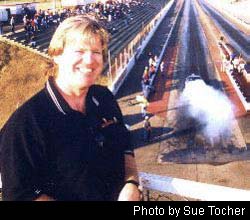
BRING ON THE EIGHTH!
7/8/05

 ell,
I used to be a doubter, but now I’m a believer—you
can race Top Fuel cars on an eighth-mile strip. The recently
completed Rocket City Nationals at Huntsville Dragway proved
it beyond any doubt, where an eight-car field satisfied
a packed house with all the nitro fire and fumes it could
handle.
ell,
I used to be a doubter, but now I’m a believer—you
can race Top Fuel cars on an eighth-mile strip. The recently
completed Rocket City Nationals at Huntsville Dragway proved
it beyond any doubt, where an eight-car field satisfied
a packed house with all the nitro fire and fumes it could
handle.
But don’t just take my word for it;
to a man (and one woman) the drivers all agreed that racing
over 660 feet is very “doable” in their 7,000-plus
horsepower machines. In fact, several suggested it may be
a better distance for the engines, with a lesser likelihood
of top-end damage and subsequent delays for track cleanup.
“I actually like it better, probably
because it costs a lot less,” Mitch King said. “Usually
when something goes wrong it’s at the top end [of
a quarter-mile pass], so as long as there’s not a
problem to start with, you’re not breaking parts.”
Parts breakage aside, the fuel teams also
agreed the actual cost to race the shorter distance is practically
the same as a quarter-mile effort. It requires the same
equipment and spares to show up, the same preparation, and
essentially the same wear-and-tear on moving parts. About
the only real change is a few gallons less fuel consumed,
which taken alone will never spell the difference between
profit and loss. Still, C.J. Nelson said the eighth-mile
event offered racers like him “something to shoot
for.”
ADVERTISEMENT
 |
|
“It’s
great for us; some of us just can’t afford to run
the national event tour, but we sure love to get out our
cars and race,” Nelson explained. “It’s
quick, too. Things happen a lot quicker over the eighth
mile, but you’re apt to blow things up a lot less.”
Indeed, I thought it quite significant that
we saw no major mechanical carnage at Huntsville. And let’s
face it, a few of the cars there would’ve been prime
oildown candidates had they been running a full quarter
mile on each pass. That we witnessed not one incident of
oil-spewing destruction is a testament to the teams, of
course, but also suggests that the shorter race distance
contributes to a shorter, tighter, and ultimately, a more
entertaining show.
No less than “Big Daddy” Don Garlits,
a man made famous a quarter mile at a time, thinks the eighth
is well-suited to nitro racing. “It’s more exciting
because as a spectator you get to see the whole race,”
he opined. “In a quarter mile, that last half they’re
just driving away.”
The abbreviated distance also presents unique
tuning challenges to the crew chiefs, as the average pass
lasts just a little over three seconds, providing precious
little time for a driver to react, pedal, and recover from
any hint of traction loss. As T.J. Zizzo said, “you’ve
got to do your homework or you’re not going to go
down the track.”
On the other hand, Tim Gibson, a finalist
in the cockpit of the Stevens’ Family entry, pointed
out that not having to account for that final stretch means
tuners have less decisions to make—but whatever decisions
they do make have got to be correct.

